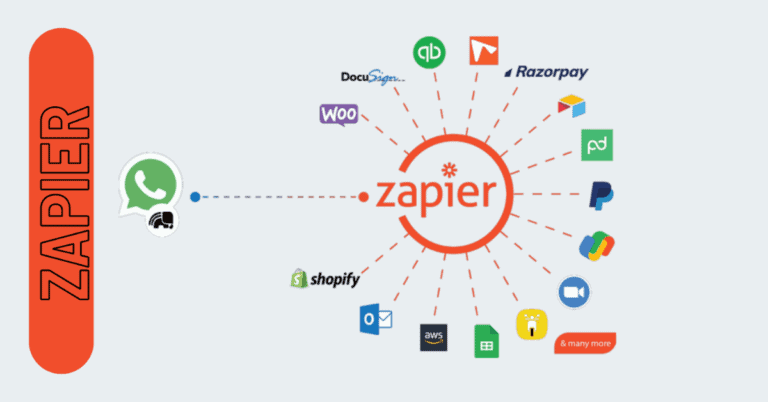Ultimate Zapier Pricing & Feature Guides: Choose the Right Plan for Workflow Automation
Tired of juggling a million tabs and repetitive tasks?
Zapier is your new best friend, the ultimate automation superhero for busy bees like you and me. ♀️♂️
Imagine this:
- New email in Gmail? Boom! It’s automatically added to your CRM.
- Someone mentions you on Twitter? Zap! You get an instant Slack notification.
- Finished a Trello card? Poof! It triggers a celebration dance (optional, but highly recommended).
That’s the magic of this tool: connecting your favorite apps and services like puzzle pieces, so they work together seamlessly without you needing to write a single line of code. (Think magic glue, but for tech!)
Who can use this time-saving wizardry? Anyone!
- Individuals: Get organized, automate social media, and reclaim your free time for more cat videos (or whatever floats your boat).
- Small businesses: Streamline marketing, sales, and customer service like a boss.
- Freelancers: Manage projects, track expenses, and impress clients with your automation skills. ✨
- Teams: Collaborate like clockwork and ditch the repetitive tasks that hold you back.
The benefits are endless:
- More time for you: Do less, achieve more.
- Fewer mistakes: Say goodbye to manual data entry blunders.
- Super organization: Everything’s in its place, always. ️
- Smoother teamwork: Collaborate like the dream team you are.
- Flexibility galore: Customize your workflows to fit your unique needs. ️
Ready to join the automation revolution? I know you are (^_^).

Table of Contents
Introduction
Zapier is a web-based automation tool that connects your favorite apps, allowing them to work together seamlessly.
It eliminates the need for manual tasks by automating workflows, thereby saving valuable time and resources.
What is Zapier?
It is an online platform that helps you automate workflows by connecting different apps and services you use.
Think of it as a glue that binds various programs together, allowing them to share information and trigger actions automatically.
How does It work?
It works through a simple yet powerful concept: connecting apps and services through triggers and actions. Here’s how it breaks down:
1. Triggers and Actions:
Triggers:
These are events that initiate an automation. For example, receiving a new email, adding a new row in a spreadsheet, or publishing a new post on social media.
Actions:
These are the tasks performed after a trigger occurs. For instance, creating a new task in your project management tool, sending an SMS notification, or updating a record in your CRM.
2. Building a Zap:
- You define a Zap, which essentially connects a trigger from one app to an action in another.
- It provides a visual interface where you can select the trigger app, action app, and configure the specific details of both.
3. Data Flow:
- When the trigger event happens, Zapier fetches the relevant data from the first app.
- This data is then processed and passed to the second app, where the specified action is performed.
4. Is coding knowledge required to use Zapier?
- It uses pre-built connectors for each app, eliminating the need for coding knowledge.
- You can customize the data mapping between the apps to ensure relevant information flows correctly.
5. Advanced Features:
- It offers advanced features like conditional branching, delays, and loops, allowing you to build complex workflows.
- You can even chain multiple Zaps together for more intricate automations.
Here’s an analogy:
Imagine Zapier as a robot that can follow your instructions. You tell the robot what event to watch for (trigger) and what to do when it happens (action). The robot then connects to different machines (apps) and carries out your commands automatically, saving you time and effort.
Features of Zapier
Connectivity:
Connects over 6,000 apps and services:
Integrates with popular tools in various categories like email, marketing, CRM, project management, social media, finance, and more.
Pre-built connectors:
No coding required, making it easy to set up automations even without technical expertise.
Automation Functionality:
Triggers and actions:
Define events to initiate automations (triggers) and tasks to be performed (actions).
Multi-step Zaps:
Chain multiple actions together for complex workflows.
Conditional branching:
Set custom conditions to determine which actions to perform based on specific data.
Filters:
Refine triggers based on specific criteria to control when actions occur.
Formatters:
Transform data between apps to ensure smooth information flow.
Usability and Management:
Visual interface:
Intuitive drag-and-drop interface simplifies building and managing Zaps.
Pre-built Zaps:
Explore a library of ready-made automations for common tasks.
Zap templates:
Get started quickly with customizable templates for specific use cases.
Testing and monitoring:
Test Zaps before deployment and monitor their performance.
Advanced Features (Paid Plans):
Zapier Tables:
Build no-code databases and connect them to your workflows.
Webhooks:
Create custom integrations with any app using webhooks.
Code steps:
Add custom code snippets for advanced functionality.
Team collaboration:
Share and manage Zaps with team members.
Increased Zap limits and data usage:
Handle more complex workflows and larger data volumes.
Additional Benefits:
Increased productivity:
Automate repetitive tasks, freeing up time for valuable work.
Improved accuracy:
Eliminate manual errors by automating data handling.
Enhanced organization:
Streamline workflows and keep data synchronized across tools.
Greater efficiency:
Focus on strategic tasks while Zapier handles routine work.
Benefits of Using it
You must be thinking: How can Zapier benefit my business?
Increased Productivity:
-
Automate repetitive tasks:
Free up your time and mental energy by automating repetitive tasks that consume your day. It can automatically move data between apps, generate reports, send emails, and more, allowing you to focus on higher-level strategic work. -
Reduced manual errors:
Eliminate the risk of human error by automating data entry and transfer between different tools. This ensures consistency and accuracy in your data. -
Faster completion of tasks:
Streamline workflows by connecting different apps seamlessly. This allows tasks to flow effortlessly through your system, reducing bottlenecks and accelerating completion times.
Improved Organization and Efficiency:
-
Centralized data management:
It helps you centralize data across different apps, eliminating the need to jump between platforms and search for information. This improves organization and makes it easier to find what you need when you need it. -
Enhanced collaboration:
Collaborate more effectively with your team by automating tasks and workflows that involve multiple members. This can keep everyone on the same page and facilitate seamless collaboration. -
Real-time updates:
Stay updated on critical information in real-time by setting up automated notifications and triggers based on specific events. This ensures you’re always aware of important changes and can react quickly.
Additional Benefits:
-
Cost savings:
By automating tasks and improving efficiency, you can potentially save time and money on resources otherwise required for manual work. -
Reduced stress:
Automating repetitive tasks can help alleviate stress and burnout, leading to a more positive and productive work environment. -
Can I customize Zapier to suit my specific requirements?:
Absolutely! It offers a high degree of customization, allowing you to tailor automations to your specific needs and preferences. -
Integrates with diverse apps:
With connections to over 6,000 apps, it can likely integrate with the tools you already use, making it a versatile solution.
Popular Zapier Integrations
Here are some of the most popular integrations across various categories:
Marketing:
Mailchimp:
Automate email marketing campaigns, manage subscribers, and track results.
Facebook Lead Ads:
Capture leads from Facebook ads and add them to your CRM or email marketing list.
HubSpot:
Connect HubSpot with other apps to automate marketing, sales, and service tasks.
ActiveCampaign:
Automate marketing workflows, send personalized emails, and track customer engagement.
Calendly:
Schedule meetings based on availability and add them to your calendar automatically.
CRM:
Zoho CRM:
Connect Zoho CRM with other apps to streamline sales and customer service processes.
Pipedrive:
Automate lead generation, follow-ups, and deal management in Pipedrive.
Freshworks CRM:
Automate tasks, manage customer interactions, and gain insights from your CRM data.
Copper:
Simplify lead capture, contact management, and communication within your CRM.
Project Management:
Trello:
Automate card creation, movement, and assignment based on triggers from other apps. Learn More >>
Asana:
Automate task creation, assignment, and due dates in Asana. Learn More >>
Monday.com:
Connect Monday.com with other apps to automate project workflows and collaboration.
ClickUp:
Automate tasks, manage projects, and track progress in ClickUp.
Wrike:
Streamline project management by automating tasks, approvals, and communication in Wrike.
Other Popular Integrations:
Gmail:
Automate email tasks, send personalized messages, and integrate email with other tools.
Google Sheets:
Automate data entry, create reports, and trigger actions based on spreadsheet changes.
Dropbox:
Automate file management, create documents, and trigger actions based on file activity.
Airtable:
Automate data management, create custom workflows, and connect Airtable with other apps.
Slack:
Automate tasks, send notifications, and integrate Slack with other communication tools. Learn More >>
How to Get Started with it
Here’s a step-by-step guide to get you started with it:
1. Explore and Plan:
Identify tasks to automate:
Think about repetitive tasks you do across different apps. For example, adding new leads to your CRM from a form, sending welcome emails to new subscribers, or updating project management tools with status changes.
Browse Zapier’s library:
Check out pre-built Zaps (automations) for common tasks in the Zapier Book. This can give you ideas and inspiration.
Choose a free plan:
The free plan allows you to create 5 Zaps per month, which is sufficient for starting small.
2. Create Your First Zap:
Go to Zapier’s website.
Sign up for a free account and then do Zapier login:
You can use your email or connect with Google/Microsoft.
Start building your Zap:
Click “Create your first Zap” or browse templates and click “Build this Zap.”
Choose your trigger:
Select the app and specific event that will initiate the automation. For example, receiving a new email in Gmail.
Choose your action:
Select the app where the action will be performed. For example, adding a new task in Trello.
Connect your accounts:
Grant Zapier access to your chosen apps by authorizing the connection.
Customize data mapping:
Map the relevant data fields between the trigger and action apps to ensure information flows correctly.
Test and turn on:
Test your Zap with a sample trigger to ensure it works as expected. If satisfied, turn it on to run automatically.
3. Learn and Explore:
Z’pr University:
Here you can explore free online courses and tutorials to learn advanced techniques.
Z’pr Blog:
Here you all can stay updated with the latest trends and tips for using it’s effectively.
Z’pr Community:
Here you folks can connect with other Zapier users, ask questions, and share your experiences.
Additional Tips:
- Start small and focus on one task at a time.
- Use pre-built Zaps when available to save time.
- Experiment and don’t be afraid to tweak your Zaps for optimal results.
- Consider exploring paid plans for more features and higher usage limits if needed.
Zapier Pricing/Cost
How secure is Zapier for sensitive data? You might be wondering about this.
Yes, the paid plan covers it as outlined below:
It offers a free plan and several paid tiers to cater to different usage needs and budgets. Here’s a breakdown of their pricing options:
Free Plan:
5 Zaps:
Create up to 5 automations per month.
Limited Triggers/Actions:
Access to popular but not all triggers and actions.
100 Tasks/Month:
Each Zap can run up to 100 tasks per month.
Basic Support:
Access to community forums and basic email support.
Paid Plans:
Starter ($19.99/month):
- 20 Zaps.
- All Triggers/Actions.
- 1,000 Tasks/Month.
- Premium Support (email and chat).
- Multi-step Zaps.
Team ($49/month):
- 50 Zaps.
- All features of Starter plan.
- Up to 3 users.
- Team Management features.
- Zap templates.
Company (Custom pricing):
- 500+ Zaps.
- All features of Team plan.
- Dedicated Account Management.
- Advanced Security features.
- Custom integrations.
Additional Points:
- You can downgrade or upgrade your plan anytime.
- Annual billing offers a 16% discount on all paid plans.
- They offer a 14-day free trial of any paid plan.
- You can purchase additional Zaps beyond your plan limit for a small fee.
Choosing the Right Plan:
Free plan:
Suitable for individuals trying out Zapier or automating a few simple tasks.
Starter:
Ideal for personal use with more complex automations or exceeding free plan limits.
Team:
Great for small teams collaborating on automations and needing team management features.
Company:
Best for large organizations with extensive automation needs and requiring advanced security and support.
Success Stories: Businesses Benefiting from Zapier
Here are some inspiring success stories of businesses utilizing Zapier to streamline their operations, boost productivity, and achieve impressive results:
Increased Leads and Sales:
Veo Robotics:
This robotics company automated lead generation by connecting their website forms with their CRM. This resulted in a 50% increase in qualified leads and a 25% improvement in conversion rates.
Taylor & Hart Jewelry:
This online jewelry retailer automated personalized email follow-ups based on customer behavior. This led to a 20% increase in repeat purchases and a 15% improvement in customer engagement
.
Enhanced Customer Service:
- ServiceTitan, a field service software company, connected their helpdesk software with Zapier. This allowed them to automatically create personalized video greetings for new customers, leading to a 30% increase in customer satisfaction and a 20% reduction in support tickets.
- Vector Media, a marketing and communications agency, streamlined their onboarding process through Zapier. They automated tasks like collecting employee information, creating accounts in various tools, and sending welcome messages. This saved them 30 hours per employee onboarding and improved the employee experience.
Boosted Efficiency and Productivity:
- Asana, a work management platform, used Zapier to automate internal processes. This included tasks like generating reports, managing expenses, and sending reminders. This saved them over 1000 hours of manual work per year and enabled them to focus on strategic initiatives.
- ActiveCampaign, an email marketing platform, increased their efficiency by using Zapier to connect with various tools. This allowed them to automate tasks like data synchronization, lead scoring, and campaign management. This led to a 30% reduction in manual work and a 20% increase in team productivity.
Tips and Tricks
Here are some tips and tricks to help you become a power user:
General:
Start small and simple:
Don’t try to build complex automations at first. Start with a basic task and gradually add complexity as you get comfortable.
Utilize pre-built Zaps:
Zapier offers thousands of pre-built Zaps for common tasks. Save time by using these instead of building from scratch.
Explore Zapier Triggers & Actions:
Familiarize yourself with the available triggers and actions. This will help you identify new automation possibilities.
Test thoroughly:
Always test your Zaps before turning them on to ensure they work as expected.
Use conditional branches:
Make your Zaps more dynamic by using conditional branches to determine which actions to perform based on specific criteria.
Schedule Zaps:
Set your Zaps to run at specific times or intervals for tasks that occur at regular periods.
Explore multi-step Zaps:
Chain multiple Zaps together for more intricate automations.
Integrate with Google Sheets:
Use Google Sheets as a bridge between different apps by manipulating data in Sheets before passing it on to another action.
Combine Zapier with other tools:
Connect Zapier with other automation tools like IFTTT or Microsoft Power Automate for even more flexibility.
Advanced:
Use webhooks:
Create custom integrations with any app using webhooks.
Implement code steps:
Add custom code snippets to your Zaps for advanced functionality.
Optimize triggers:
Use filters and delays to fine-tune when your Zaps trigger.
Leverage Zapier Tables:
Build no-code databases within Zapier and connect them to your workflows.
Monitor and troubleshoot:
Zapier offers tools to monitor the performance of your Zaps and troubleshoot any issues.
Join the Zapier community:
Get help and learn from other users in the Zapier community forum.
Additional Tips:
Document your Zaps:
Maintain documentation for your Zaps to understand their purpose and functionality easily.
Think outside the box:
Don’t limit yourself to common use cases. Explore creative ways to leverage Zapier for unique automations.
Stay up-to-date:
Keep yourself informed about new features and functionalities by following Zapier’s blog and social media channels.
Zapier Competitors and Alternatives
While Zapier is a popular automation platform, it’s not the only option available. Here are some noteworthy alternatives:
Free & Freemium Options:
-
IFTTT:
Offers simple automations (“recipes”) across various apps and services. Ideal for basic needs and experimenting with automation. -
Parabola:
Visual data management tool with automation capabilities. Powerful for manipulating and analyzing data across platforms. -
Pabbly Connect:
User-friendly interface for connecting apps and automating workflows. Budget-friendly for basic to medium automation needs. -
Make (formerly Integromat):
Robust platform with numerous integrations and advanced features. Free plan supports limited triggers and actions. -
Coupler.io:
Free plan connects 2 apps with unlimited workflows. Focuses on simplicity and ease of use.
Paid Options:
-
Microsoft Power Automate:
Part of the Microsoft Power Platform, integrates well with Microsoft products and offers advanced features. -
Tray.io:
Powerful platform for complex enterprise-level workflows and integrations. -
Workato:
Cloud-based solution with AI-powered features for managing complex workflows and integrations. -
Boomi:
Enterprise-grade integration platform with robust security and governance features. -
HubSpot Operations Hub:
Built for marketing and sales automation, integrates seamlessly with HubSpot CRM and other tools.
Choosing the Right Alternative:
Consider these factors when evaluating alternatives:-
Budget:
Free or paid options available. -
Needs:
Complexity of your desired automations. -
Integrations:
Apps and services you need to connect. -
Features:
Advanced capabilities like conditional branching or data manipulation. -
Ease of use:
Interface and learning curve. -
Scalability:
Ability to grow with your needs.
*** Conclusion ***
Frequently Asked Questions
Is Zapier suitable for small businesses?
Can I create custom integrations with Zapier?
Are Zapier automations reliable?
Can Zapier integrate with legacy systems?
How can I learn more about Zapier?
What is Zapier used for?
Is Zapier free to use?
Is Zapier an AI tool?
Is Zapier a CRM?
No, Zapier is not a CRM (Customer Relationship Management) tool itself. While it can be used to connect and automate tasks within CRMs, it doesn’t offer the core functionalities of a typical CRM like storing contact information, managing sales pipelines, or generating reports.
What are some alternatives to zapier?
Here are some alternatives to Zapier without descriptions:
Free and open-source:
- n8n
- Parabola
- IFTTT
Paid:
- Make (formerly Integromat)
- Workato
- Tray.io
What is the best use of Zapier you have seen?
- Marketing automation (social media sharing, email campaigns, lead tracking)
- Customer service automation (support ticket responses, invoices, surveys)
- Productivity hacks (data entry, to-do lists, collaboration)
- Data management (reports, analysis, backups)
- Creative integrations (text message alerts, social media triggers, custom actions)
Why is Zapier so popular?
- No-code: Easy automation for everyone, no coding skills needed.
- Vast integrations: Connects thousands of apps, covering broad uses.
- Boosts productivity: Saves time, optimizes workflows across platforms.
What are the 5 things to automate in Zapier?
Top 5 Zapier automations:
- Social media sharing
- Data flow (leads, customers, etc.)
- Alerts & reminders
- Data management (backups, analysis)
- Project tasks
















